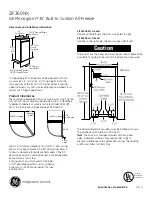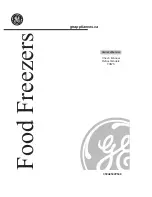
EN-21
HFD17690EI
Refrigeration and freezing
Risk of injury!
Improper handling of the combination
fridge freezer may result in injury.
• Touching the frozen interior walls or
food with wet hands can injure your
skin. Skin damage can occur even
with dry skin. Use a dry cloth to pick
up the frozen food.
• Direct contact with the frozen food
poses a risk of ice burns. Therefore, do
not put ice cubes or ice lollies straight
into your mouth from the freezer.
NOTICE
Risk of damage!
Improper handling of the combination
fridge-freezer may lead to damage.
• Do not freeze carbonated drinks! Wa-
ter expands when frozen and can
burst the container.
• Only freeze strong alcohol standing
upright and closed tightly.
• Do not store glass or metal containers
of liquid.
– Follow the instructions in this chapter to
store your food over the longest possible
time in the best possible way.
Freezing food has a positive effect on its shelf
life. You can also avoid food waste in this way.
– Set the temperature in the freezer to –18 °C
and fill the fridge in such a way that the
temperature conditions inside are optimally
utilised, guaranteeing optimal food storage:
• Place food to be frozen in the freezer
drawers.
To maintain the taste and nutritional value of
your frozen food, to ensure that your combina-
tion fridge-freezer does not use too much elec-
tricity, and to prevent the freezer from having to
be defrosted unnecessarily often, please note:
– Frozen food requires a constant storage
temperature of -18 °C.
– The maximum freezing capacity in the event
of a fault is shown on the appliance’s type
plate.
– Freeze only good-quality food that has been
prepared, portioned and packaged in a way
that suits its properties.
– If possible, freeze ready-made meals in
portion sizes too. Small portions are quicker
to freeze to the core. It is also more eco-
nomical to freeze several small portions
than to throw away the remainder of a larger
portion.
– Freeze raw or prepared meat, poultry and
fish in household-sized portions and later
defrost them in the fridge. Make sure not to
let food such as meat sit in its own thawing
liquid.
– Freeze fresh and prepared food without
salt or seasoning. Unsalted foods are more
durable.
– To prevent frozen food from drying out, tak-
ing on a strange taste or leaking, use robust
packaging that is airtight, waterproof, not too
rigid, easy to seal and easy to label.
– Follow the manufacturer’s instructions when
storing ready-made frozen food.
– Keep to recommended storage times and
temperatures.
– When putting fresh food into the freezer,
make sure that it does not come into contact
with food that is already frozen, as this may
defrost.
– Allow prepared food to cool before freezing.
This not only saves energy, but also pre-
vents excessive frost formation in the com-
bination fridge-freezer.
– Do not freeze full drink bottles. Liquids ex-
pand during freezing and the bottles can
burst.
Quick freezing
If you are putting a lot of frozen food into the
freezer or want to freeze food as carefully and
quickly as possible:
Pre-cool the freezer before putting in the food.
TEMP.ZONE
/HOLD 3SEC SUPER FRZ.
SUPER COOL
3. Press the
SUPER COOL
button for
3 seconds.










































